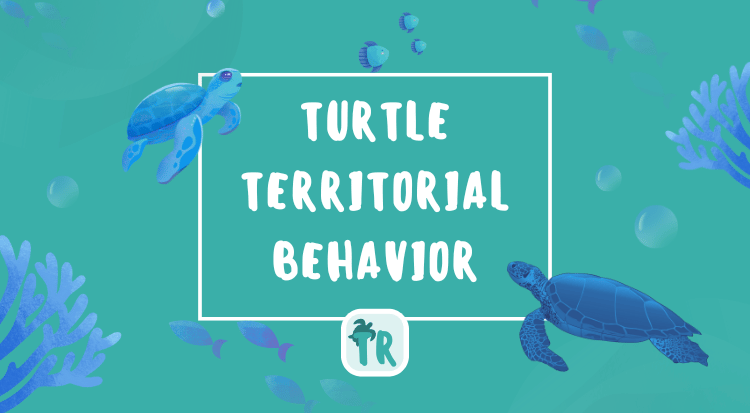Turtle Territorial Behavior - Pet Owners Beware
Learn about territorial behavior in turtles with our comprehensive guide. Discover how to recognize signs of aggression and manage territoriality to keep your pet turtles safe and happy.

Turtles, often perceived as calm creatures, can exhibit territorial behavior, especially when sharing space with other turtles. Understanding this aspect of their behavior is crucial for pet owners, empowering them to create a harmonious environment and prevent conflicts.
This guide will delve into the reasons behind turtles' territorial behavior, how to recognize the signs, and what you can do to manage it. By gaining insight into your turtle's territorial instincts, you can confidently create a safe and comfortable habitat for all your shelled friends.
What Is Territorial Behavior?
Territorial behavior is when an animal defends a specific area it considers its own. In turtles, this can involve aggressive actions to keep other turtles or animals away from their space.
- Defending Resources: Turtles may guard basking spots, feeding areas, or hiding places.
- Establishing Dominance: Territoriality can be a way to assert dominance over other turtles.
- Natural Instinct: In the wild, turtles establish territories to ensure access to resources necessary for survival.
Signs of Territorial Behavior
Recognizing the signs of territoriality can help you address issues before they escalate.
Aggressive Actions
Turtles may show aggression towards others in their territory.
- Biting and Nipping: Attempting to bite another turtle.
- Ramming: Pushing or bumping into others forcefully.
- Chasing: Pursuing other turtles to drive them away.
Posturing
Body language can indicate territorial intentions.
- Head Raising: Lifting the head high to appear larger.
- Extending Limbs: Stretching out legs to occupy more space.
- Shell Display: Turning the shell towards a perceived intruder.
Vocalizations
Though generally quiet, some turtles may make sounds.
- Hissing: A defensive noise signaling discomfort or aggression.
- Grunting: This may occur during confrontations.
Factors Influencing Territorial Behavior
Several factors can contribute to territoriality in turtles.
Space Constraints
Limited space increases competition.
- Small Enclosures: Crowded habitats force turtles to compete for resources.
- Lack of Hiding Spots: Insufficient shelters can lead to conflicts.
Resource Availability
The scarcity of essential resources prompts territorial actions.
- Basking Areas: A single basking spot may become a contested area.
- Food Access: Competition for food can trigger aggression.
Gender and Species
Some turtles are more prone to territoriality.
- Males: Male turtles often exhibit more territorial behavior, especially during mating seasons.
- Species Differences: Certain species are naturally more aggressive.
Health and Stress
Stress can amplify territorial instincts.
- Illness: A sick turtle may become more irritable.
- Environmental Stress: Poor habitat conditions can increase aggression.
Managing Territorial Behavior in Pet Turtles
Taking proactive steps can help reduce territorial disputes.
Provide Adequate Space
Ensuring enough room for each turtle minimizes conflicts.
- Larger Enclosures: Upgrade to a bigger tank or habitat.
- Separate Areas: Create distinct zones within the habitat.
Multiple Resources
Offer duplicates of essential items to reduce competition. For instance, you can provide several basking areas, each with its own heat lamp, or use multiple feeding locations, ensuring each turtle has its own space to eat.
- Basking Spots: Provide several basking areas.
- Feeding Stations: Use multiple feeding locations.
Habitat Enrichment
Enhance the environment to keep turtles engaged.
- Hiding Places: Add logs, caves, or plants for privacy.
- Visual Barriers: Use decorations to break the line of sight between turtles.
Monitor Interactions
Regular observation helps identify issues early.
- Watch for Aggression: Note any signs of fighting or stress.
- Behavioral Changes: Be alert to shifts in activity levels.
Separate Aggressive Turtles
If conflicts persist, consider housing turtles separately.
- Individual Enclosures: Provide separate habitats for aggressive individuals.
- Temporary Isolation: Time apart may reduce tension.
Introducing New Turtles
Bringing a new turtle into an established habitat requires careful planning.
Quarantine
Keep the new turtle separate initially.
- Health Screening: Ensure the new turtle is healthy.
- Gradual Introduction: Slowly introduce scents and visuals before physical contact.
Neutral Territory
Introduce turtles in a neutral space. This could be a separate, unfamiliar area where neither turtle has established a territory. Clean the habitat and rearrange it to eliminate established territories, then supervise the turtles closely during their initial meetings.
- Clean Habitat: Rearrange the habitat to eliminate established territories.
- Supervised Interaction: Monitor the turtles closely during initial meetings.
Understanding Natural Behavior
Recognizing that some territoriality is natural can help you manage expectations.
Accepting Hierarchies
Turtles may establish a social order.
- Dominance: One turtle may naturally become the leader.
- Submissive Behaviors: Less dominant turtles may yield without conflict.
Seasonal Changes
Territorial behavior may vary with seasons.
- Mating Season: Increased aggression is common during breeding times.
- Adjustments: Be prepared to modify the habitat during these periods.
Safety Measures
Protect your turtles from harm due to territorial aggression.
Regular Health Checks
Ensure all turtles are healthy.
- Inspect for Injuries: Look for bites, scratches, or other wounds.
- Address Illnesses: Treat any health issues promptly.
Stress Reduction
Minimize stress to reduce aggression.
- Stable Environment: Maintain consistent temperatures and lighting.
- Quiet Area: Place the habitat in a low-traffic area of your home.
Professional Advice
Consult experts when needed.
- Veterinarian Guidance: Seek advice if aggression leads to injuries.
- Behavior Specialists: Professionals can offer solutions for persistent issues.
Conclusion
Understanding territorial behavior in turtles allows you to create a harmonious environment for your pets. By recognizing the signs of aggression and the factors that contribute to territoriality, you can take steps to prevent conflicts.
Providing ample space, multiple resources, and a stimulating habitat can significantly reduce territorial disputes. Remember that some level of hierarchy is natural among turtles, and monitoring their interactions is vital. You can ensure your shelled companions live together safely and happily with attentive care and management.
